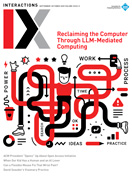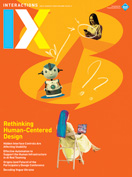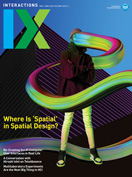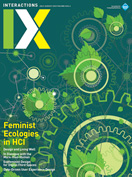Table of Contents
VOLUME XXX.4 July - August 2023
-
WELCOME
-
Feminist Ecologies
Elizabeth Churchill, Mikael Wiberg
In this issue we foreground feminist ecologies in HCI. Accordingly, we take a relational approach to thinking about feminism as a collective movement, but also as a shared long-term struggle. Indeed, communal belonging, collective efforts, and an ability to move forward together might be more important than ever. As…
-
-
What are you reading?
-
What are you reading? Serene Koh
Serene Koh

The core of what I do is to understand human behavior and to help design policies, programs, and products that take into account how people naturally behave (rather than how we expect them to behave). What I read professionally helps give me insights into the two parts of this…
-
-
Blog@IX
-
Hidden in Plain Sight: Discreet User Interfaces
Kyle Boyd, Raymond Bond, Maurice Mulvenna, Karen Kirby, Susan Lagdon, Becca Hume

Do you feel safe when you travel alone? That was a question I asked my girlfriend (now wife) as we took a trip on a relatively empty train when I was visiting her at university. "I always carry my phone with me, but sometimes it's actually worse when the…
-
-
Columns
-
Reframing Data’s Doing
Jonathan Bean

The 2020 book Data Feminism, by Catherine D'Ignazio and Lauren F. Klein [1], seems to have broken through. I have been seeing it on recommended reading lists and in library diversity, equity, and inclusion collections, and hearing about it from colleagues, who are discussing it in academic book clubs.…
-
Can We Break the Horizontal Lines of Whorism?
Jaz Hee-jeong Choi, Martyna Miller, Susanna Paasonen

For the first time, this column has more than two named authors. This is consequential to the last one Jaz and Susanna wrote, to which Martyna contributed images from her art project Sexinsitu (see images 20–22 here for examples of the work: https://secondaryarchive.org/artists/martyna-miller/). The original images we had chosen…
-
-
Making/breaking
-
Shredit: Breaking a Shredder and Making It into a Phone
Max Angenius, Roksana Patrzałek, Simone Brandão

Shredit is a design concept for a tangible artifact for making phone calls more playful and inefficient. The artifact uses drawing and document shredding as the primary forms of interaction. It is built by deconstructing an electric shredder and connecting it to an Arduino with an LCD screen. To…
-
-
Forums
-
Data-Driven User Experience Design
Rae Yule Kim

Data is increasingly important for user experience (UX) designers. One example of a data-driven UX strategy is the personalized recommendation algorithm. As one of the leaders in this technology, Amazon collects customer data about their shopping and search patterns to derive personalized recommendations, which, in turn, optimizes user experiences…
-
Access Work: Laboring with Non-Innocent Authorization
Louise Hickman, Cynthia Bennett

In this conversation, we reflect on what access work means to us as disabled scholars who conduct research on disability and technology. To arrive at this phrase, in addition to our empirical work, we draw from three sources. First, Access to Work is a U.K.-based government program that funds…
-
-
Community square
-
ReCHInnected!
Andrew Kun
-1.jpg)
The #reCHInnecting was real. CHI this year saw 3,888 attendees on-site in Hamburg, Germany, with another 782 online, representing 79 countries in total, according to numbers shared by General Chairs Albrecht Schmidt and Kaisa Väänänen at the opening plenary. The diversity across the conference was a delight to behold,…
-
-
Features
-
Implications of Human-Computer Interaction Research
Niels van Berkel, Kasper Hornbæk

The field of human-computer interaction covers a broad set of methods, viewpoints, and application areas. While the real-world impact of our research is typically impossible to predict, HCI researchers generally seek for their work to have implications that go beyond an individual paper. For example, a study on the…
-
Data-Driven User Experience Design
Rae Yule Kim

Data is increasingly important for user experience (UX) designers. One example of a data-driven UX strategy is the personalized recommendation algorithm. As one of the leaders in this technology, Amazon collects customer data about their shopping and search patterns to derive personalized recommendations, which, in turn, optimizes user experiences…
-
-
Dialogues
-
A Preamble to Feminist Ecologies in HCI
Gopinaath Kannabiran, Marie Louise Juul Søndergaard

On March 25, 1974, Gaura Devi, elected leader of the Mahila Mangal Dal (women's welfare association) in Reni village, Uttarakhand, India, along with 27 other women, led the Chipko movement to protect the local community forest from government-sanctioned lumbermen. Devi explains: "It was not a question of planned organisation…
-
In Dialogue with the More-than-Human: Affective Prefiguration in Encounters with Others

I have been talking about practices that give people the chance to feel differently. Not only to feel different, but to feel relationships that are not ubiquitously available at present. I call this affective prefiguration. Insights → To effect urgent change, we require different capacities for feeling as…
-
From Menstrual Care to Environmental Care
Nadia Campo Woytuk, Marie Louise Juul Søndergaard

Between 2021 and 2022, we immersed ourselves in a very personal and caring design process for our newly funded project, Biomenstrual. In the project we sought to explore sustainable menstrual care, speculating on how human menstrual cycles might touch and be touched by more-than-human actors in many ways: from…
-
A Soil Dialogue
Anton Poikolainen Rosén, Vasanth Madhav Kamath, Gopinaath Kannabiran

In this dialogue about, through, and with soil, we use soil samples from Sweden and India to discuss the mutual interdependence of soil health and just sustainability transitions from a feminist perspective. We describe how we have come to know our soil and what role information technologies play in…
-
Ecofeminist Design for Digital Third Spaces
Deepa Singh, Kay Kender

Our experiences of otherness intertwined with our sociality are rife with alienation and exclusion, as we are forced to navigate spaces that are inherently not designed for us. In this existential experience of being in the world, marked by ever-present otherness, we seek spaces of belonging where we feel…
-
Design and Living Well
Gopinaath Kannabiran, Heather McKinnon

This dialogue aims at exchanging ideas and exploring intersections between ecological and feminist issues in our work. As early-career design researchers, we are comparing notes on areas of common interest. Gopi's research work in HCI is informed and inspired by ecological feminism (ecofeminism), while Heather contributes to sustainable HCI…
-
-
Calendar
-
Calendar
INTR Staff

July DAC '23: 60th ACM/IEEE Design Automation Conference (San Francisco, CA, USA) July 9–13, 2023 https://www.dac.com/ DIS '23: ACM Designing Interactive Systems (Pittsburgh, PA, USA) July 10–14, 2023 https://dis.acm.org/2023/ CUI '23: ACM Conference on Conversational User Interfaces (Eindhoven, The Netherlands) July 19–21, 2023 https://cui.acm.org/2023/ PEARC '23: Practice and Experience…
-
-
Exit
-
A Mother’s Voice. Rages. Global Warnings
Alicia Piller

Contributor: Alicia Piller, Track 16 Gallery, [email protected] Curator/Editor: Nia Easley Alicia Piller's A Mother's Voice. Rages. Global Warnings. (2022) is an homage to the activist Helen Jones-Phillips, whose son, John Horton, died while being held at Los Angeles's central jail. Copyright held by author The Digital Library is…
-



